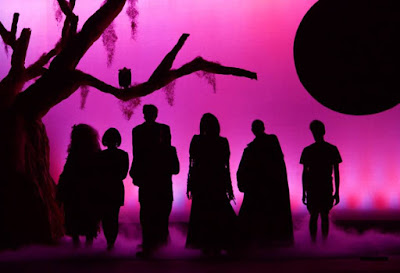Before the musical, before the movies, before the first TV series, there were those exquisitely detailed one-panel drawings by Charles "Chas" Addams. At five, I asked my baby sitter Mrs. Wilson to sit me on her lap and explain Addams' humor to me, my initiation to irony.
But what I really loved were the drawings themselves. I could spend quiet hours peering into his cobwebbed corners, imagining what lurked down dark halls, finding little faces in the black space behind shards of cracked windows. Bliss was to watch the show before bedtime on Friday nights, to lay my Addams cartoon collection Homebodies on the bedside table, and to wake before anyone else in the house Saturday morning to leaf through those drawings week after week, admiring their skill, making up my own stories about them.
All of this is to say that I brought a lot of Addams baggage with me to see the musical. To see those silhouettes emerge from memory onto the live stage was a visceral thrill, met with wild applause. [See photo: This and photos following come from the collection of designer Bill Schreiner, the Walker School.]
The Addams Family was performed at the Walker School, Marietta, GA, by grown-up former students of mine, directed by choreographer Katie Arjona, designed by Bill Schreiner, with vocal director Samantha Walker. I saw the show twice, on Thursday November 12 and Friday the 13th. Aside from being delighted by the actors, chorus, and band, I came away admiring what the creators had done.

Working with the same plot as, gosh, every half-hour episode of the TV show -- normal people meet the Addamses -- the writers (Marshall Brickman and Rick Elice, book; Andrew Lippa, music and lyrics) gave themselves room to explore Addams' world. "What's 'normal' for you may be asinine for others," Morticia says. "Normal" means being from "the real America" outside of New York, where people adhere to life plans, and stay cheerful by keeping anything "dark" to themselves. The Addamses are cosmopolitan -- we see ghostly ancestors from Spain, France, and even Viking territory -- and spontaneous enough to fire an arrow blindfolded at a lover or to rocket Uncle Fester to the moon when he gets a notion to go. In an anthem intoned by taciturn Lurch, they "Move Toward the Darkness." That thought is developed in a great parody of songs that tell us, when things are down, to look for "that silver lining," "flowers that bloom in May," or "pennies from heaven": Morticia thinks happily how Death is "Just Around the Corner."
So much of the show is silly, but its creators take family seriously. No one laughed when Morticia repeated the vows from her wedding to Gomez: "Dance every day, for passion; share everything, for honesty." The opening number brings back generations of Addamses to witness and facilitate the action: Here's a family for whom family is everything.
With strong voice and withering sneer, Briana Keegan played a thoroughly millennial "Wednesday," loathing herself for being "pulled in a new direction" by romance. Every time she sang "pulled," she stretched her brother Pugsley with chains on a rack. Dylan Alfi played a punk "Pugsley," getting laughs and sympathy at the same time when he sings of losing his sister and chief torturer. Affable, energetic, and gloriously voiced, David Simpson played the love interest, who hands Wednesday a blindfold in my favorite moment of the whole show. His tight-buttoned parents were played by Connor Barre and Meghan Dresdner, who both get to let loose, showing off their vocal and comic chops. Sean Nesmith was "Uncle Fester," sweet and funny as our host for the evening. His moon dance was an audience favorite. Jesse Baynes made a gloriously earthy "Grandma." On platform shoes as the giant "Lurch," silent Harrison Pritchett got some of the biggest laughs of the evening just plodding to a door and heaving his shoulders with one sigh of resignation. Deb Kemp, charismatic as "Morticia," was often the still center to a manic stage picture who could reduce the audience to helpless laughter with just the rise of an eyebrow. But she could break into song and dance, too, with her perfectly matched "Gomez," Kenneth Laster, who performed with strong voice, sure step, and irrepressible enthusiasm.
Like Addams's original cartoons, Bill Shreiner's set gave us something interesting to look at wherever our eyes wandered in the vast space of the auditorium (formerly a basketball court). Todd Motter kept up a spirited pace with the costumed orchestra from Vic Mizzy's inevitable theme (four note arpeggio, snap, snap) to the finale nearly three hours later. Voices were clear, strong, in tune, and self-assured, thanks to Samantha Walker's vocal direction. The whole package was the work of director Katie Arjona, who insisted on, and got, professionalism and warmth.



No comments:
Post a Comment